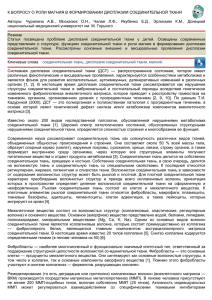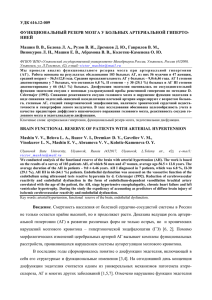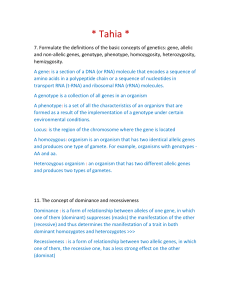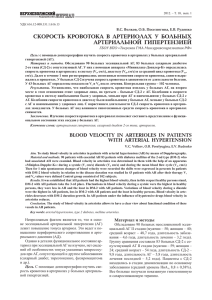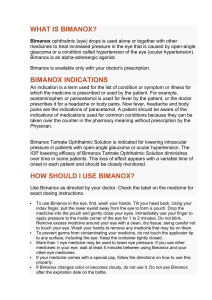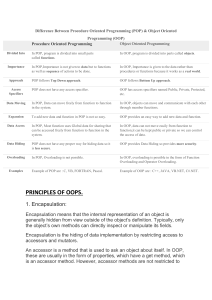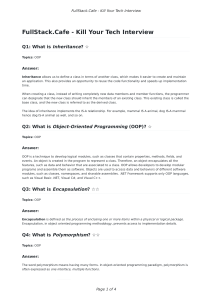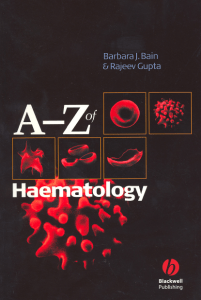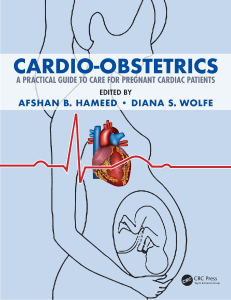ГЕНЕТИЧЕСКИЙ ПОЛИМОРФИЗМ В ПАТОГЕНЕЗЕ ЛЕВОГО ЖЕЛУДОЧКА
реклама
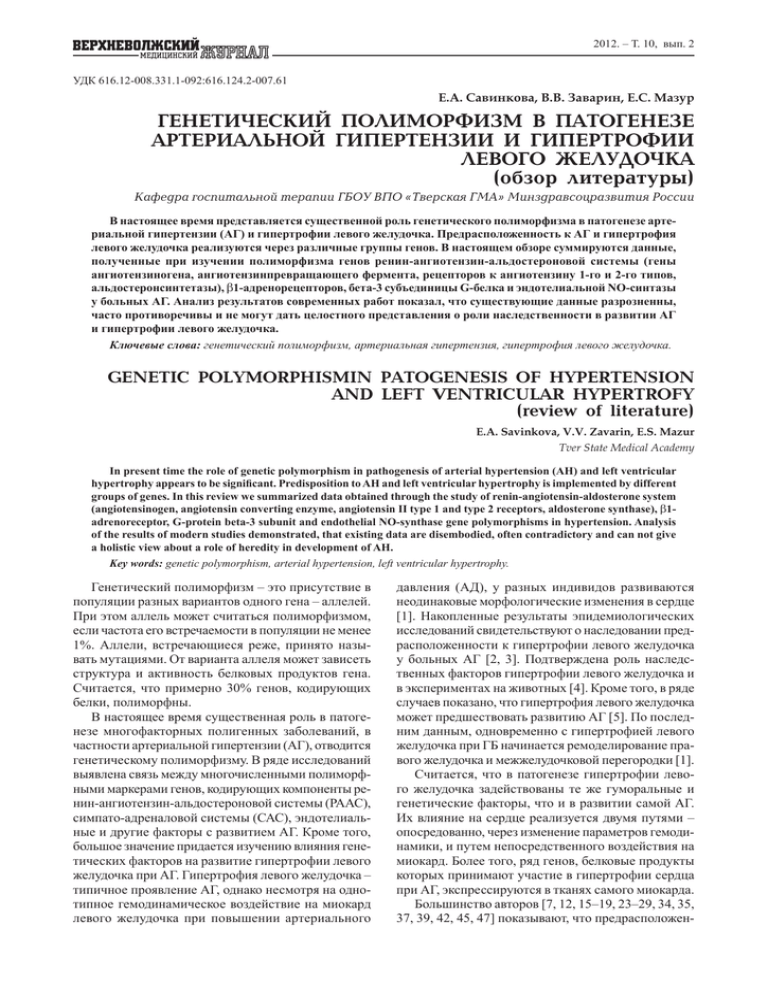
2012. – . 10, .2 616.12-008.331.1-092:616.124.2-007.61 . . , . . , . . ГЕНЕТИЧЕСКИЙ ПОЛИМОРФИЗМ В ПАТОГЕНЕЗЕ АРТЕРИАЛЬНОЙ ГИПЕРТЕНЗИИ И ГИПЕРТРОФИИ ЛЕВОГО ЖЕЛУДОЧКА (обзор литературы) Кафедра госпитальной терапии ГБОУ ВПО «Тверская ГМА» Минздравсоцразвития России ( ) . . , , - ( , ), 1- , 1- -3 G- . 2NO- , , , . : , , . GENETIC POLYMORPHISMIN PATOGENESIS OF HYPERTENSION AND LEFT VENTRICULAR HYPERTROFY (review of literature) E.A. Savinkova, V.V. Zavarin, E.S. Mazur Tver State Medical Academy In present time the role of genetic polymorphism in pathogenesis of arterial hypertension (AH) and left ventricular hypertrophy appears to be significant. Predisposition to AH and left ventricular hypertrophy is implemented by different groups of genes. In this review we summarized data obtained through the study of renin-angiotensin-aldosterone system (angiotensinogen, angiotensin converting enzyme, angiotensin II type 1 and type 2 receptors, aldosterone synthase), 1adrenoreceptor, G-protein beta-3 subunit and endothelial NO-synthase gene polymorphisms in hypertension. Analysis of the results of modern studies demonstrated, that existing data are disembodied, often contradictory and can not give a holistic view about a role of heredity in development of AH. Key words: genetic polymorphism, arterial hypertension, left ventricular hypertrophy. – ( – . , ), [1]. - 1%. , , [2, 3]. . - . , 30% , [4]. , - [5]. , ( [1]. - ), , - ( - ( ), . ), , - , , , – - . – - , , . . - , . - , , . , 37, 39, 42, 45, 47] , , . [7, 12, 15–19, 23–29, 34, 35, , - 2012. – . 10, ( , , , - ), ( [11], 235 . - - . . . - ( ( ) ( ). - - - . ). , , : ( ) ( ( , , II - ), , , ( ) . 287 . [13], , . II , , D. [15], DD- , - (DD). - H. Schunkert , 1994 - - . [16], . ( )– - / (insertion/deletion – I/D) 16 . B. Rigat . [14], L. Tiret , , - , , , DD- - . ) . [6, 7, 12, 15–19, 22–29, 34, 35, 37] - , (AGT), (ACE), (AGTR1), (AGTR2) 1- ( II. (17q23) , ) , I ) I - 174 . [12] - G), ( .2 - - 2(CYP11B2) . , 1919 [17, 18]. . . , . [19], ID. - DD . . , D , ( )– , - , , ACE [20, 11]. I. ( . - . 1 q42–43). X. Jeunemaitre 15 1992 AGT . AGT, - DD- , - , , [21]. 235 174 235 [6]. – 174 , 1- [7]. , 235 [8–10], 1- ( 1- ), , , 2012. – . 10, , . .2 , 1- , , - GAGTR2, . . AGTR1 , 3q21-q25. – G- – , 50 AGTR1. 3’- , 1166( 1166 ). AGTR1 . Bonnardeaux , , - , – - , – . 1166 . 1994 , - [22]. G- - [29]. , , , - - 2- [30]. . S. Takami [23] II . [24, 25] - – , . [12, 26], , , . . : . . , 2- 2- ( , ) , 2- , . 2- 1- , , , , , . , . , , , , , . , II [31]. 2- , AGTR1 . . AGTR2 - - . , . II . G1675A, G- , , , 2- , . [31–33]. (CYP11B2) - - 8q22. , - , . R. Schmieder G, . [27] - , , -344 / , . , - , . S. Herrmann , G- M. Kupari . [34] - . . EPOGH (European Project On Genes in Hypertension) 815 , . - , . [28] , , - , - - 2012. – . 10, .2 [35]. , , [36]. . [37] M. Isaji , , 24- , - -3- G- II, . G NONOS3 NONOS3 [43]. 7q35-36. - NO- , . G- ) G ,G ,G . . Glu298Asp - ( - . . , . : - 3 Glu298Asp, eNOS [44]. 298Asp G. – G s , G i, . GNB3, [38, 40, 41] [39]. GNB3 9[38] 1998 , - . . . [45] Glu298 . , 4 - -3- G- , (NOS3 4a/4b 4 27 27 4 , . X. Wang 4b – 5 . [46] 825, . - W. Siffert E. Poch [39] , - . 41- . 4b/4b. 2000 , . . - 4 1- - - . (ADRB1) - G. . - , – , , . 10- , 4 [47]. . [45, 48] . 1- 4 , - . [42] . ). 1- , . , . – Gly389Arg Ser49Gly. . . 2001 . - . - , . - - . Arg/Arg 1. . NO. - , – NO. , . . . . – 2009. – 2. – . 24–27. 2. Schunkert H., Bryckel U., Hengstenberg C. et al. Familial predisposition of left ventricular hypertrophy // J. Am. Coll. Cardiol. – 1999. – Vol. 33, 6. – P. 1685–1691. 3. Post W.S., Larson M.G., Myers R.H. et al. Heritability of left ventricular mass: the Framingham Heart Study // Hypertension. – 1997. – Vol. 30, 5. – P. 1025–1028. 4. Tanase H., Yamori Y., Hansen C. et al. Heart size in inbred strains of rats. Part 1. Genetic determinants of the development of cardiovascular enlargement in rats // Hypertension. – 1982. – Vol. 4, 6. – P. 864–872. 2012. – . 10, 5. Devereux R.B., de Simone G., Koren M.J. et al. Left ventricular mass as a predictor of development of hypertension // Amer. J. Hypertens. – 1991. – Vol 4, 11. – P. 603S–607S. 6. Jeunemaitre X., Soubrier F., Kotelevtsev Y.V. et al. Molecular basis of human hypertension: role of angiotensinogen // Cell. – 1992. – Vol. 71, 1. – P. 169–180. 7. Jeng J.-R. Left ventricular mass, carotid wall thickness, and angiotensinogen gene polymorphism in patients with hypertension // Am. J. Hypertens. – 1999. – Vol. 12, 5. – P. 443–450. 8. Wong K.K., Summers K.M., Burslow D.J. et al. Angiotensinconverting enzyme and angiotensinogen genes in patterns of left ventricular hypertrophy and in diastolic dysfunction // Clin. Exp. Pharmacol. Physiol. – 1995. – Vol. 22, 6–7. – P. 438–440. 9. Kauma H., Ikäheimo M., Savolainen M.J. et al. Variants of renin-angiotensin system genes and echocardiographic left ventricular mass // Eur. Heart. J. – 1998. – Vol. 19, 7. – P. 1109–1117. 10. Fernández-Llama P., Poch E., Oriola J. at al. Angiotensinogen gene M235T and T174M polymorphisms in essential hypertension. Relation with target organ damage // Am. J. Hypertens. – 1998. – Vol. 11, 4. – P. 439–444. 11. Shlyakhto E.V., Shwartz E.I., Neferova Y.B. et al. Lack of Association of the Renin-angiotensin System Genes Polymorphisms and Left Ventricular Hypertrophy in Hypertension // Blood Pressure. – 2001. – Vol. 10, 3. – P. 135–141. 12. . ., . ., . . . // . – 2001. – 41, 7. – . 39–44. 13. Rigat B., Hubert C., Alhenc-Gelas F. et al. An insertion/ deletion polymorphism in the angiotensin I-converting enzyme gene accounting for half the variance of serum enzyme levels // J. Clin. Invest. – 1990. – Vol. 86, 4. – P. 1343–1346. 14. Tiret L., Rigat B., Visvikis S. et al. Evidence, from combined segregation and linkage analysis, that a variant of the angiotensin I-converting enzyme (ACE) gene controls plasma ACE levels // Am. J. Hum. Genet. – 1992. – Vol. 51, 1. – P. 197–205. 15. Schunkert H., Hense H.-W., Holmer S.R. et al. Association between a deletion polymorphism of the angiotensin-convertingenzyme gene and left ventricular hypertrophy // N. Engl. J. Med. – 1994. – Vol. 330, 23. – P. 1634–1638. 16. Iwai N., Ohmichi N., Nakamora Y. et al. DD Genotype of the Angiotensin-Converting Enzyme Gene is a Risk Factor for Left Ventricular Hypertrophy // Circulation. – 1994. – Vol. 90, 6. – P. 2622–2628. 17. Gharavi A.G., Lipkowitz M.S., Diamond J.A. et al. Deletion Polymorphism of the Angiotensin-Converting Enzyme Gene is Independently Associated with Left Ventricular Mass and Geometric Remodeling in Systemic Hypertension // Am. J. Cardiol. – 1996. – Vol. 77, 15. – P. 1315–1319. 18. Kimura M., Yokota M., Fujimura T. et al. Association of a deletion polymorphism of the angiotensin-converting enzyme gene with left ventricular hypertrophy in Japanese women with essential hypertension: multicenter study of 1919 subjects // Cardiology. – 1997. – Vol. 88, 4. – P. 309–314. 19. . ., . . , // . . – 1997. – 69, 9. – . 18–23. 20. Gomez-Angelats E., Enguto M., Oriola J. et al. Lack of association between ACE gene polymorphism and left ventricular hypertrophy in essential hypertension // J. Hum. Hypertens. – 2000. – Vol. 14, 1. – P. 47–49. 21. Kuznetsova T., Staessen J.A., Wang J.G. et al. Antihypertensive treatment modulates the association between the D/I ACE gene polymorphism and left ventricular hypertrophy: a metaanalysis // J. Hum. Hypertens. – 2000. – Vol. 14, 7. – P. 447–454. 22. Bonnardeaux A., Davies E., Jeunemaitre X. et al. Angiotensin II type 1 receptor gene polymorphisms in human essential hypertension // Hypertension. – 1994. – Vol. 24, 1. – P. 63–69. 23. Takami S., Katsuya T., Rakugi H. et al. Angiotensin II type1 receptor gene polymorphism is associated with increase of .2 left ventricular mass but not with hypertension // Am. J. Hypertens. – 1998. – Vol. 11, 3. – P. 316–321. 24. Castellano M., Muiesan M.L., Beschi M. et al. Angiotensin II type 1 receptor A/C 1166 polymorphism. Relationships with blood pressure and cardiovascular structure // Hypertension. – 1996. – Vol. 28, 6. – 1076–1080. 25. Hamon M., Amant C., Bauters C. et al. Association of angiotensin converting enzyme and angiotensin II type 1 receptor genotypes with left ventricular function and mass in patients with angiographically normal coronary arteries // Heart. – 1997. – Vol. 77, 6. – P. 502–505. 26. . ., . ., . . . AGTR1 // . . – 2004. – 46, 6. – . 990–996. 27. Schmieder R.E., Erdmann J., Delles C. et al. Effect of the Angiotensin II type 2-Receptor Gene (+1675 G/A) on Left Ventricular Structure in Humans // J. Am. Coll. Cardiol. – 2001. – Vol. 37, 1. – P. 175–182. 28. Herrmann S.M., Nicaud V., Schmidt-Petersen K. et al. Angiotensin II type 2 receptor gene polymorphism and cardiovascular phenotypes: the GLAECO and GLAOLD studies. Eur // J. Heart Fail. – 2002. – Vol 4, 6. – p. 707–712. 29. Kuznetsova T., Staessen J.A., Thijs L. et al. Left Ventricular Mass in Relation to Genetic Variation in Angiotensin II Receptors, Renin System Genes, and Sodium Excretion // Circulation. – 2004. – Vol. 110, 17. – P. 2644–2650. 30. Armando I., Jezova M., Juorio A.V. et al. Estrogen upregulates renal angiotensin II AT2 receptors // Am. J. Physiol. Renal Physiol. – 2002. – Vol. 283, 5. – P. F934 – F943. 31. Weber K.T., Brilla C.G. Myocardial fibrosis and the reninangiotensin-aldosterone system // J. Cardovasc. Pharmacology. – 1992. – Vol. 20, 1. – P. 48–54. 32. Brilla C.G., Zhou G., Weber K.T. Aldosterone-mediated stimulation of collagen synthesis in cultured cardiac fibroblasts // J. Hypertension. – 1992. – Vol. 10, Supl. 4. – P. S125–S130. 33. Samuel J.L., Barrieux A., Dufour S. et al. Accumulation of fetal fibronectin mRNAs during the development of rat hypertrophy induced by pressure overload // J. Clin. Invest. – 1991. – Vol. 88, 5. – P. 1737–1746. 34. Kupari M., Hautanena A., Lankinen L. et al. Associations between the human aldosterone synthase (CYP11B2) gene polymorphism and left ventricular size, mass, and function // Circulation. – 1998. – Vol. 97, 6. – P. 569–575. 35. Delles C., Erdmann J., Jacobi J. et al. Aldosterone Synthase (CyP11B2) -344 C/T Polymorphism is Associated With Left Ventricular Structure in Human Arterial Hypertension // J. Am. Coll. Cardiol. – 2001. – Vol. 37, 3. – P. 878–884. 36. Schunkert H., Hengstenberg C., Holmer S.R. et al. Lack of association between a polymorphism of the aldosterone synthase gene and left ventricular structure // Circulation. – 1999. – Vol. 99, 17. – P. 2255–2260. 37. Isaji M., Mune T., Takada N. et al. Correlation between left ventricular mass and urinary sodium excretion in specific genotypes of CYP11B2 // J. Hypertension. – 2005. – Vol. 23, 6. – P. 1149–1157. 38. Siffert W., Rosskopf D., Siffert G. et al. Association of a human G protein beta3 subunit variant with hypertension // Nat. Genet. – 1998. – Vol. 18, 1. – P. 45–49. 39. Poch E., González D., Gómez-Angelats E. et al. G-Protein 3 Subunit Gene Variant and Left Ventricular Hypertrophy in Essential Hypertension // Hypertension. – 2000. – Vol. 35, 1. – P. 214–218. 40. Brand E., Herrmann S.M., Nicaud V. et al. The 825C/T polymorphism of the G-protein subunit 3 is not related to hypertension // Hypertension. – 1999. – Vol. 33, 5. – P. 1175–1178. 41. Kato N., Sugiyama T., Morita H. et al. G protein 3 subunit variant and essential hypertension in Japanese // Hypertension. – 1998. – Vol. 32, 5. – P. 935–938. 42. . ., . ., . . . - 2012. – . 10, .2 gene to plasma nitric oxide levels. Arterioscler // Thromb. Vasc. Biol. – 1997. – Vol. 17, 11. – P. 3147–3153. 47. Nakayama ., Soma M., Takahashi Y. et al. Association analysis of CA repeat polymorphism of Endothelial Nitric Oxide Synthase Gene with Essential Hypertension // Clin. Genet. – 1997. – Vol. 51, 1. – P. 26–30. 48. . ., . ., . . : // . – 2010. – 50, 1. – . 9–14. 43. Miyamoto Y., Saito Y., Kajiyama N. et al. Endothelial Nitric Oxide Synthase Gene Is Positively Associated With Essential Hypertension // Hypertension. – 1998. – Vol. 32, 1. – P. 3–8. 44. Hingorani A.D. Endothelial nitric oxide synthase polymorphisms and hypertension // Curr. Hypertens. Rep. – 2003. – Vol. 5, 1. – P. 19–25. 45. . ., . ., . . . NO// . – 2002. – 42, 1. – . 30–34. 46. Wang X.L., Mahaney M.C., Sim A.S. et al. Genetic contribution of the endothelial constitutive nitric oxide synthase 40, // 3. – C. 69–77. . – 2000. – ( ) – . . ., , . . . . 77-54-22. 616.153.915-008.61 . . , . . О ПАТОАУТОКИНЕЗЕ ГИПЕРЛИПОПРОТЕИДЕМИИ И ЕГО КЛИНИЧЕСКОМ ЗНАЧЕНИИ Кафедра патологической физиологии ГОУ ВПО «Тверская ГМА» Минздравсоцразвития России : ( - ) ). ( . 3 , - - (25–30 , 60 1 - ). , J 131 . 30–40 - , , 50% . . , . . . . : , . ON PATHOAUTOKINESIS OF HYPERLIPOPROTEIDEMIA AND ITS CLINICAL SIGNIFICANCE M.N. Kalinkin, V.S. Volkov Tver State Medical Academy The aim: to deted the presence of pathoautokinesis signs in development and maintenance of hyperlipoproteidemia (HLP) in experiments on intact rabbits and the rabbits after long-term intravenous injection of lipoproteids (LP). Material and methods. 3 series of experiments on rabbits which received for 60 days intravenous homologous apo-Bcontaining LP (25–30 mg LP per 1 kg of the body mass) were carried out. Correspondence of calculated and true values of injected LP, duration of HLP maintenance after LP injection termination and the body response to single injection of interlipin as well as character of elimination with J 131 apo-B-LP from blood alteration of the liver homogenates have been studied. Results. It has been that in 50% of rabbits with experimental HLP, the true values of intravenously injected LP are higher than calculated ones. In rabbits after LP injection termination HLP arisen lasts for 30–40 days and intralipid injection induces prolonged HLP. The values of radioactivity of plasma LP in HLP testify to their difficult elimination from blood and their accumulation in the liver. Conclusion. Mechanisns of pathoautokinesis are present in HLP development and maintenance. Key words: pathoautokinesis, hyperlipoproteidemia. - ( ). , . . - , [1], « , « 21 , », -

